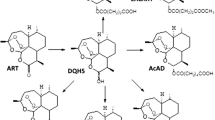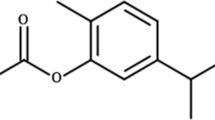Abstract
The present work aimed to study the effect of phenyl vinyl sulphone (PVS), a CPI, on different stages of Schistosoma (S.) mansoni in an in vitro culture study and in experimentally infected mice, compared to PZQ. As regards the in vitro study, different concentrations of PVS (1, 2, 4, 6, 8 and 10 µg/ml) and PZQ (1 µg/ml) were assessed by % worm mortality for schistosomula and adults, and hemoglobin degradation by schistosomula. In vivo study included 8 groups of mice. Intraperitoneal PVS, subgroup (a), and oral PZQ, subgroup (b), were assessed at different durations post infection (pi); at 1, 3, 5 and 7 weeks pi (groups I, II, III and IV, respectively). Infection, PVS, PZQ, and normal control groups (groups V–VIII) were included. The anti-schistosomal effects of PVS were assessed by parasitological, histopathological and haematological parameters. In in vitro study, PVS had a schistosomicidal effect in a concentration and time dependent manner, PVS showed 100% schistosomula mortality at day 2 and 92% adult worm mortality at day 5. Furthermore, PVS decreased hemoglobin degradation by schistosomula. In in vivo study, PVS showed a decrease in total worm burden and tissue egg load in intestine and liver with an increase in number of dead ova in intestine of mice. Furthermore, PVS resulted in a decrease in number, size and cellularity of hepatic granulomas and an increase in hemoglobin concentration.PVS was better than PZQ in reducing each of tissue egg count in intestine at 5 and 7 weeks pi, and hepatic granuloma size at 3, 5 and 7 weeks pi. These results suggest that PVS can be a promising chemotherapeutic agent in Schistosoma mansoni infection.









Similar content being viewed by others
References
Abaza SA, El-Moamly AA, Ismail OA, Alabbassy MM (2013) Cysteine protease inhibitors (Phenyl vinyl sulfone and valproic acid) in treatment of schistosomiasis mansoni-infected mice: an experimental study to evaluate their role in comparison to praziquantel. PUJ 6(1):99–108
Abdulla M, Lim KC, Sajid M, McKerrow JH, Caffrey CR (2007) Schistosomiasis mansoni: novel chemotherapy using a cysteine protease inhibitor. PLoS Med 4(1):130–138
Abdulla MH, Ruelas DS, Wolff B, Snedecor J, Lim KC, Fengyun X, Adam RR, Janice W, McKerrow JH, Caffrey CR (2009) Drug discovery for schistosomiasis: hit and lead compounds identified in a library of known drugs by medium-through put phenotypic screening. PLoS Negl Trop Dis 3(7):e478
Botros S, William S, Beadle LR, Valiaeva N, Hostetler KY (2009) Anti-schistosomal activity of hexadecyloxypropyl cyclic 9-(S)-[3-Hydroxy-2-(phosphonomethoxy) propyl] adenine and other alkoxyalkyl esters of acyclic nucleoside phosphonates assessed by schistosome worm killing in vitro. Antimicrob A Chemother 53(12):5284–5287
Caffrey CR (2007) Chemotherapy of schistosomiasis: present and future. Curr Opin Chem Biol 11:433–439
Cheever AW (1968) Conditions affecting the accuracy of potassium hydroxide digestion techniques for counting Schistosoma mansoni eggs in tissues. Bull WHO 39:328–331
Cioli D, Pica-Mattoccia L (2002) Praziquantel. Parasitol Res 90(1):53–59
Correnti JM, Brindley PJ, Pearce EJ (2005) Long-term suppression of cathepsin B levels by RNA interference retards schistosome growth. Mol Biochem Parasitol 143(2):209–215
Dalton JP, Smith AM, Clough KA, Brindley PJ (1995) Digestion of haemoglobin by schistosomes: 35 years on. Parasitol Today 11:299–303
Danso-Appiah A, Olliaro PL, Donegan S (2013) Drugs for treating Schistosoma mansoni infection. Coranche Database Syst Rev 2:CD000528
Druray RA, Wallington EA (1980) Carletonʼs histological technique, 5th edn. Oxford University Press, Oxford, New York, pp 195–210
El Beshbishi SN, Taman A, El Malky M, Azab MS, El Hawary AK, El Tanatwy DA (2013) First insight into the effect of single oral dose therapy with artemisinin–naphthoquine phosphate combination in a mouse model of Schistosoma mansoni infection. Int J Parasitol 43:521–530
Fahmy ZH, Helmy AM (2007) Assessment of cysteine protease in schistosomiasis and haematolgical parasitogical role of its inhibitor in the control of the disease. New Egypt J Med 39:1–7
Farid A, Ismail A, Rabee I, Zalat R, El Amir A (2013a) Study of the efficacy of cysteine protease inhibitors alone or combined with praziquantel as chemotherapy for mice schistosomiasis mansoni. Int J Med Health Biomed Bioeng Pharm Eng 7(12):849–856
Farid A, Malek AA, Rabie I, Helmy A, El Amir AM (2013b) Overview on cysteine protease inhibitors as chemotherapy for Schistosomiasis mansoni in mice and also its effect on the parasitological and immunological profile. Pak J Biol Sci 16(24):1849–1861
Feldman BF, Zinkl JG, Jain NC (2000) Hematology of the mouse (Mus musculus). In: Lippincott W, Wilkins (eds) Schalm’s veterinary hematology, 5th edn. Philadelphia, London, pp 1210–1224
Helmy MM, Fahmy ZH, Sabry HY (2008) Fasciola gigantica: evaluation of the effect of phenyl vinyl sulfone in vitro. Exp Parasitol 119(1):125–134
Hinz R, Schwarz NG, Hahn A, Frickmann H (2017) Serological approaches for the diagnosis of schistosomiasis—a review. Mol Cell Probes 31:2–21. doi:10.1016/j.mcp.2016.12.003
Issa RM (2007) Schistosoma mansoni: the prophylactic and curative effects of propolis in experimentally-infected mice. Rawal Med J 32:94–98
Jacobs W, Bogers J, Deelder A, Wery M, Van Marck E (1997) Adult Schistosoma mansoni worms positively modulate soluble egg antigen-induced inflammatory hepatic granuloma formation in vivo. Stereological analysis and immunophenotyping of extracellular matrix proteins, adhesion molecules, and chemokines. Am J Pathol 150:2033–2045
Keiser J, El Ela NA, El Koumy E, El Lakany N, Diab T, Chollet J, Utzinger J, Barakat R (2006) Triclabendazole and its two main metabolites lack activity against Schistosoma mansoni in mouse model. Am J Trop Med Hyg 75(2):287–291
Morsy GH (2009) Parasitological and histopathological studies on schistosomiasis mansoni infected mice and treated with praziquantel and/or oltipraz. J Egypt Soc Parasitol 39(2):687–701
Neves JKAL, Sarinho S, De Melo CML, Pereira VRA, De Lima MCA, Pitta IR, Albuquerque MCPA, Galdino SL (2011) Immunological studies and in vitro schistosomicide action of new imidazolidine derivatives. J Ven Anim Toxicol Trop Dis 17(3):277–286
Pellegrino J, Faria J (1965) The oogram method for the screening of drugs in schistosomiasis mansoni. Am J Trop Med Hyg 14:363–369
Peters PA, Warren KS (1969) A rapid method of infecting mice and other laboratory animals with Schistosoma mansoni: subcutaneous injection. J Parasitol 55(3):558
Pinto-Almeida A, Mendes T, de Oliveira RN, CorrêaSde A, Allegretti SM, Belo S, Tomás A, Anibal Fde F, Carrilho E, Afonso A (2016) Morphological characteristics of Schistosoma mansoni PZQ-resistant and -susceptible strains are different in presence of Praziquantel. Front Microbiol 26(7):594
Sebaugh JL (2011) Guidelines for accurate EC50/IC50 estimation. Pharm Stat 10(2):128–134
Shenai BR, Lee BJ, Alvarez-Hernandez A, Chong PY, Emal CD, Neitz RJ, Roush WR, Rosenthal PJ (2003) Structure activity relationships for inhibition of cysteine protease activity and development of Plasmodium falciparum by Peptidyl Vinyl Sulfones. Antimicrob Agents Chemother 47(1):154–160
Smithers SR, Terry RJ (1965) Infection of laboratory hosts with cercariae of Schistosoma mansoni and the recovery of adult worms. Parasitology 55:695–700
Tohon ZB, Mainassara HB, Garba A, Mahamane AE, Bosqué-Oliva E, Ibrahim M, Duchemin J, Chanteau S, Boisie P (2008) Controlling schistosomiasis: significant decrease of anaemia prevalence one year after a single dose of praziquantel in Nigerien schoolchildren. PLoS Negl Trop Dis 2(5):e241
Vermeire JJ, Lantz LD, Caffrey CR (2012) Cure of hookworm infection with a cysteine protease inhibitor. PLoS Negl Trop Dis 6(7):e1680
Wang W, Wang L, Liang YS (2012) Susceptibility or resistance of praziquantel in human schistosomiasis: a review. Parasitol Res 111(5):1871–1877
Wasilewski MM, Limb KC, Jennifer P, McKerrow JH (1996) Cysteine protease inhibitors block schistosome hemoglobin degradation in vitro and decrease worm burden and egg production in vivo. Mol Biochem Parasitol 81:179–189
Xiao SH, Catto BA, Webster LT Jr (1985) Effects of praziquantel on different developmental stages of Schistosoma mansoni in vitro and in vivo. J Infect Dis 151(6):1130–1137
Author information
Authors and Affiliations
Corresponding author
Ethics declarations
Conflict of interest
We wish to confirm that there are no known conflicts of interest associated with this publication and there has been no significant financial support for this work that could have influenced its outcome. We confirm that the manuscript has been read and approved by all named authors and that there are no other persons who satisfied the criteria for authorship but are not listed. We further confirm that the order of authors listed in the manuscript has been approved by all of us.
Ethical approval
The study was approved by the Research Ethics Committee, Faculty of Medicine, Ain Shams University. All the animal experiments were performed according to the rules and regulation of the Animal Ethics rules, Ain-Shams University, Cairo, Egypt.
Rights and permissions
About this article
Cite this article
Mahmoud, M.S.ED., Ibrahim, A.N., Badawy, A.F. et al. Effect of phenyl vinyl sulphone cysteine protease inhibitor on Schistosoma mansoni: in vitro and in vivo experimental studies. J Parasit Dis 41, 1049–1058 (2017). https://doi.org/10.1007/s12639-017-0933-3
Received:
Accepted:
Published:
Issue Date:
DOI: https://doi.org/10.1007/s12639-017-0933-3




